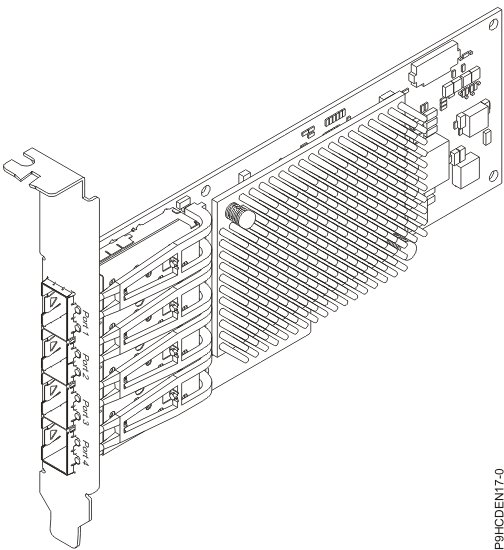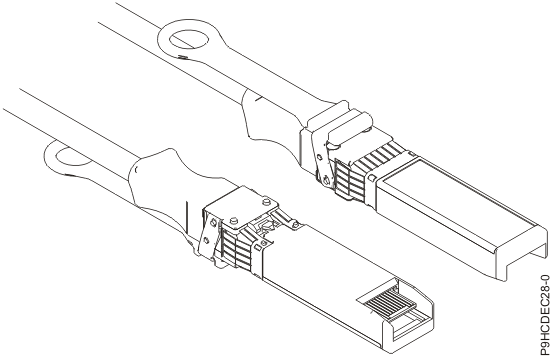PCIe3 4-port 10 GbE SFP+ Copper Adapter (FC EN17 and FC EN18; CCIN 2CE4)
Learn about the specifications and operating system requirements for the feature code (FC) EN17 and FC EN18 adapter.
Overview
- FC EN17: PCIe3 4-port 10 GbE SFP+ Copper Adapter
- FC EN18: PCIe3 LPX 4-port 10 GbE SFP+ Copper Adapter
The PCIe3 4-port 10 GbE SFP+ copper adapter is a PCI Express (PCIe) generation 3, x8, short form-factor adapter. The adapter provides four 10 Gb small form-factor pluggable (SFP+) ports into which copper twinax transceivers will be placed. See Figure 1. Active copper twinax cables up to 5 meter in length are supported such as provided by feature codes EN01, EN02 or EN03. A transceiver is included with these cables. See Cables for details. The adapter supports the Ethernet network interface controller (NIC) function and also provides SR-IOV NIC support. SR-IOV capability for the NIC function is supported with the appropriate firmware and operating system level for any of the four ports. Enabling the SR-IOV function requires an HMC.
- Four 10 Gb ports that can function in the NIC mode
- AIX® Network Installation Management (NIM) support
- The adapter supports interrupt moderation to deliver increased performance while significantly reducing processor utilization
- The adapter supports multiple media-access control (MAC) per interface.
- The adapter supports integrated media-access control (MAC) and physical layer (PHY).
- The adapter supports the following standards for the different ports and functions:
- IEEE 802.3ae in the 10 GbE ports
- 802.3ab in the 1 GbE ports
- Ether II and IEEE 802.3 for encapsulated frames
- 802.1p for setting up priority levels in tagged VLAN frames
- 802.1Q for VLAN tagging
- 802.3x for flow control
- 802.3ad for load-balancing and failover
- IEEE 802.3ad and 802.3 for link aggregation
- The adapter provides message signal interrupts (MSI), MSI-X, and support of legacy pin interrupts.
- The adapter supports jumbo frames up to 9.6 KB.
- The adapter supports TCP checksum offload transmission control protocol (TCP), user datagram protocol (UDP), TCP segmentation Offload (TSO) for IPv4 and IPv6.
- Supports TCP segmentation or large send offload
- Supports EEPROM-SPI and single EEPROM

Specifications
- Item
- Description
- Adapter FRU number
- 00ND463
- Wrap plug FRU number
- 74Y7010 (Twinax wrap plug)
- I/O bus architecture
- PCIe3 x8
- Slot requirement
- For details about slot priorities, maximums, and placement rules, see PCIe adapter placement rules and slot priorities and select the system you are working on.
- Voltage
- 3.3 V
- Form factor
- Short, full-height tailstock, low-profile capable
- Cables
- See Cables for details.
Cables

| Cable length | Feature code | CCIN | Part number |
|---|---|---|---|
| 1 m (3.28 ft) | EN01 | EF01 | 46K6182 |
| 3 m (9.84 ft) | EN02 | EF02 | 46K6183 |
| 5 m (16.4 ft) | EN03 | EF03 | 46K6184 |
Operating system or partition requirements
- The latest version of enabling libraries and utilities can be downloaded from the Fix Central website.
- Power Systems Prerequisites website.
- IBM System Storage Interoperation Center (SSIC) website.
- The latest version of the device driver or IBM Power® RAID adapter utilities (iprutils) can be downloaded from the IBM Service and Productivity Tools website.
- For information about important notices for Linux on IBM Power Systems, see the Linux® on IBM website.